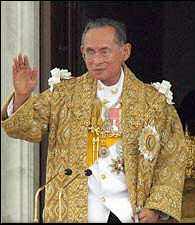|
December 5 is the 87th birthday anniversary of His Majesty King Bhumibol Adulyadej, Rama IX, the King of Thailand. In the picture accompanying this essay HM the King is wearing his distinctive symbol of office, his ceremonial robe. This symbol incorporates several strands of tradition in somewhat the same way crowns do in Europe. In fact, there are seven pieces of regalia the King received on his coronation in 1950, but these days it is the robe that every Thai person recognizes, while the rest (including “The Great Crown of Victory”) are rarely used even on major occasions.
Julia Brannan and Yaowalak Bunnag produced a definitive study of “Thai Official Rank Robes (Sua Khrui)”. They describe the history and methods of producing these robes. See www.caringfortextiles.com/site3/wp.../Arts-of-Asia-March-2014.pdf Brannan and Yaowalak explain that HM the King’s robe “…is constructed of a netted fabric worked with…embroidery and … embellishment on top….” “…the exclusively royal robe with ‘solidly overall’ gold-thread net that can include gold thread or beetle wings, or sequins.” The thread for the net base is made of either gold thread or gold wound around a silk core. For lesser officials the net can be of other metallic thread or of silk alone. The gold net of the robe is made with a special technique called thak ta chun. The method of knotting is taught only in the Thai royal court. The knot looks similar to a common “fisherman’s knot”. It is a loose knot creating a very open mesh. The variation in the size of the loops, density of the honeycomb-like fabric, selection of threads and the skill of the artist could create gossamer or dense cloth. The embroidery of the King’s robe is “solidly overall” meaning that the net is entirely filled in. The resulting robe weighs about five kilograms (11.2 pounds). During the early reigns of the restored Siamese Kingdom after the fall of Ayutthaya in 1767 the production, ownership and use of ceremonial robes was strictly controlled. No one could have such a robe without the King’s grace. The robe for the King was produced in the inner court, in a special workshop, supervised by a prince. Then the robe was bestowed in a highly ritualized rite to insure the unbroken sequence of tradition. As far as can be speculated historically, the style of the robe can be traced back to Persia. There were Persian advisers and experts in rites and rituals in the courts of the Khmer (Cambodian) monarchs in Angkor Thom as well as in Ayutthaya which followed. The role of the Persians was supplemented and then taken over by Brahmin advisers in the 18th century. Brannan and Yaowalak tell us, “The Kings’ robes are very specifically embellished with royal symbols, such as nagas (mythical serpents), Garuda (mythical bird and Vishnu’s mount) and even insignia or monograms.” These latter symbols would specify the monarch for which the robe was made, while the former symbols would link the monarch (and him alone) to the mythical roots of the cultural tradition, and reiterate that he is an incarnation or direct descendant of those who created the universe.
0 Comments
Leave a Reply. |
AuthorRev. Dr. Kenneth Dobson posts his weekly reflections on this blog. Archives
March 2024
Categories |
| Ken Dobson's Queer Ruminations from Thailand |
|

 RSS Feed
RSS Feed
